Seismic Vulnerability Assessment of Residential RC Buildings in Yemen Using Incremental Dynamic Analysis (IDA)
Abstract
1. Introduction

2. Building Types and Methodology
2.1. Representative Buildings
| Frame Type | Low Rise | Medium Rise | |
|---|---|---|---|
| 3 Stories | 5 Stories | 7 Stories | |
| Bare Frame (BF) | BF3 | BF5 | BF7 |
| Infill Frame (IF) | IF3 | IF5 | IF7 |
| Frame with Soft-Story (SSF) | SSF3 | SSF5 | SSF7 |

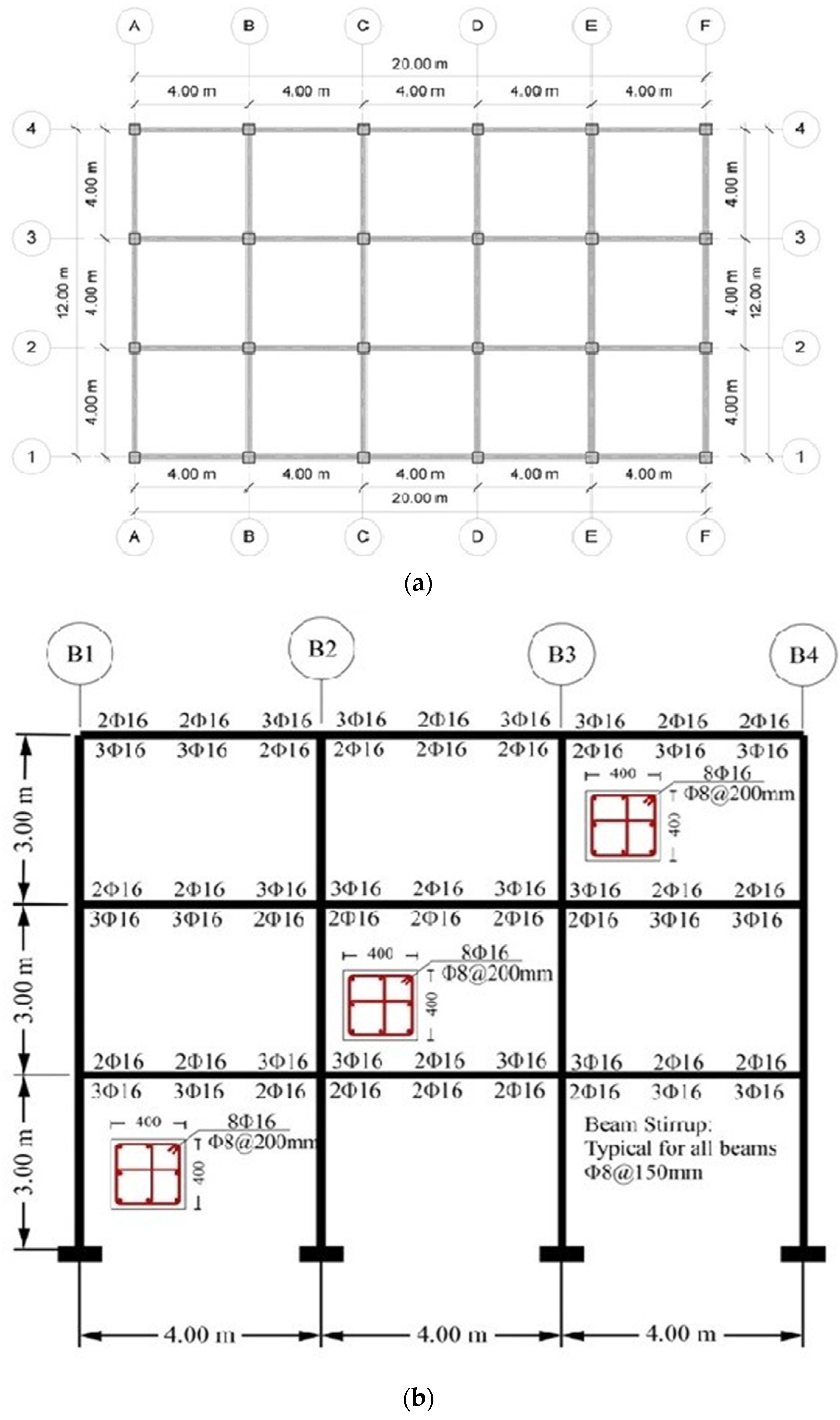

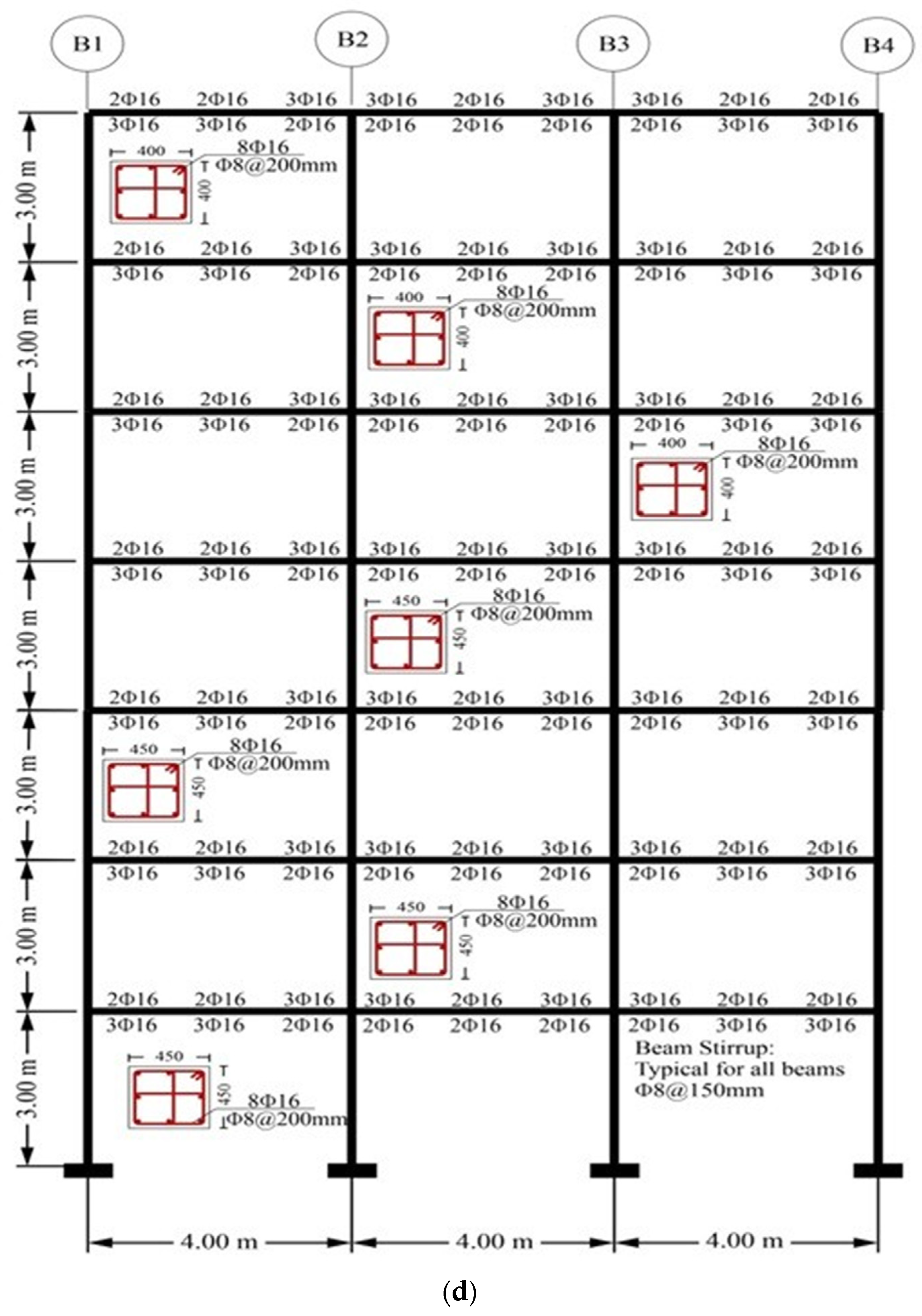
2.2. Structural Design of the Buildings
- Torsional effects are neglected,
- The buildings are modeled as beam–column skeletons (ordinary frames) with 200 mm thick hollow concrete blocks for all infill walls,
- In the Bare Frame (BF) model, infill walls are not considered structural elements, but their weight is included in the building’s total weight for the IDA. In the Infilled Frame (IF) and Soft-Story Frame (SSF) models, the infill walls are considered structural elements. Infill walls have traditionally been viewed as non-structural elements meant to enclose spaces, provide thermal and acoustic insulation, and enhance architectural aesthetics. However, modern construction practices increasingly recognize infill walls as structural components that contribute to the overall stability and performance of buildings. When properly designed and integrated, infill walls can improve structural stiffness, resist lateral loads, and enhance seismic performance. This shift in perspective underscores the need to consider infill walls integral to the structural system, requiring careful analysis and design to ensure their compatibility with the primary load-bearing framework. This paper examines the structural role of infill walls, their interaction with the main structural system, and their implications for building performance under various loading conditions.
- The slab is assumed to behave as a rigid diaphragm; consequently, the lateral load in each of the main directions is distributed to the vertical elements (i.e., columns) in accordance with its stiffness ratio.
| Material Properties | Values |
|---|---|
| Typical concrete compressive strength—f′c | 25 MPa |
| Typical longitudinal reinforcements yield strength—fy | 280 MPa |
| Typical transverse reinforcements yield strength—fyv | 280 MPa |
| Building Name | Vibration Period (s) | |
|---|---|---|
| X-Direction | Y-Direction | |
| BF3 | 0.426 | 0.433 |
| IF3 | 0.170 | 0.178 |
| SSF3 | 0.276 | 0.280 |
| BF5 | 0.583 | 0.596 |
| IF5 | 0.271 | 0.286 |
| SSF5 | 0.389 | 0.398 |
| BF7 | 0.810 | 0.834 |
| IF7 | 0.374 | 0.399 |
| SSF7 | 0.497 | 0.514 |
2.3. Incremental Dynamic Analysis (IDA)
| Earthquake Name | Year | Station Name | Magnitude | PGA (%g) | Mechanism | Rjb (km) | Vs30 (m/s) |
|---|---|---|---|---|---|---|---|
| Northwest Calif | 1938 | Ferndale City Hall | 5.5 | 0.42 | strike-slip | 52.73 | 219.31 |
| Imperial Valley | 1940 | El Centro Array #9 | 6.95 | 0.34 | strike-slip | 6.09 | 213.44 |
| Central Calif | 1960 | Hollister City Hall | 5 | 0.25 | strike-slip | 7.28 | 198.77 |
| Parkfield | 1966 | Cholame—Shandon Array #5 | 6.19 | 0.32 | strike-slip | 9.58 | 289.56 |
| Hollister | 1974 | Hollister City Hall | 5.14 | 0.34 | strike-slip | 8.85 | 198.77 |
| Oroville | 1975 | Pacific Heights Rd (OR4) | 4.7 | 0.32 | Normal | 8.7 | 352.22 |
| Coyote Lake | 1979 | Gilroy Array #2 | 5.74 | 0.34 | strike-slip | 8.47 | 270.84 |
| Westmorland | 1981 | Niland Fire Station | 5.9 | 0.29 | strike-slip | 15.16 | 212 |
| Borrego | 1942 | El Centro Array #9 | 6.5 | 0.32 | strike-slip | 56.88 | 213.44 |
| Nicaragua | 1972 | Managua-ESSO | 6.24 | 0.30 | strike-slip | 3.51 | 288.77 |
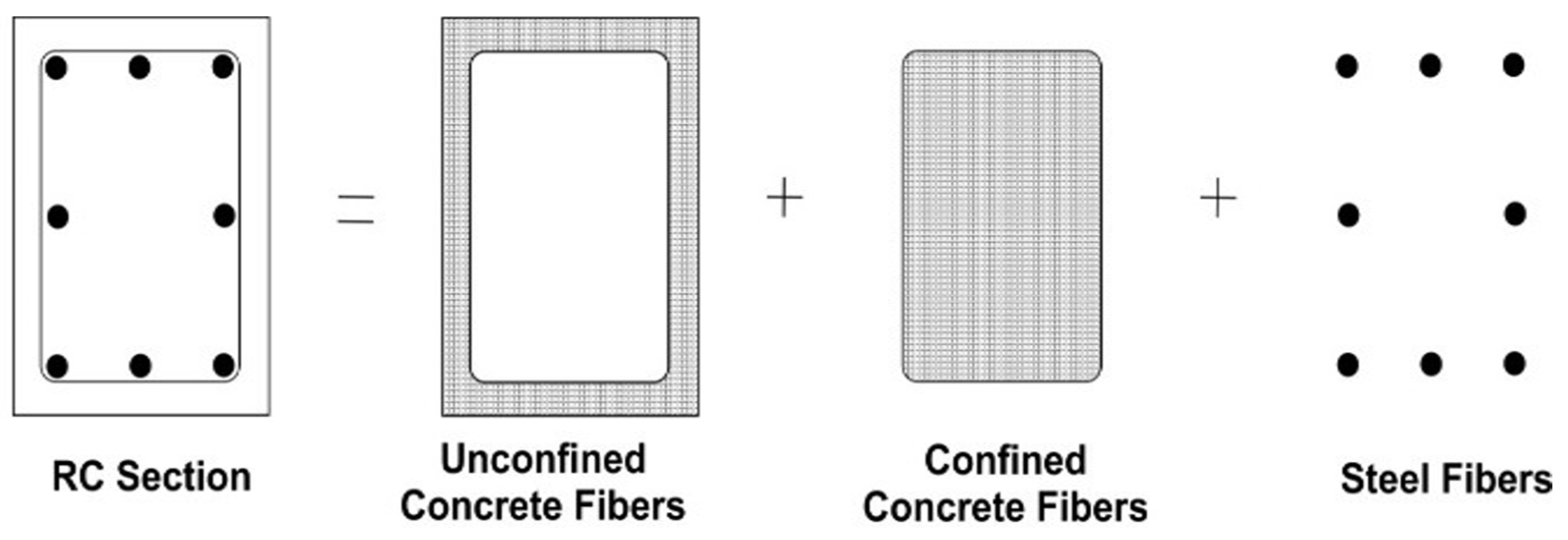
2.3.1. Modeling of Infill Wall
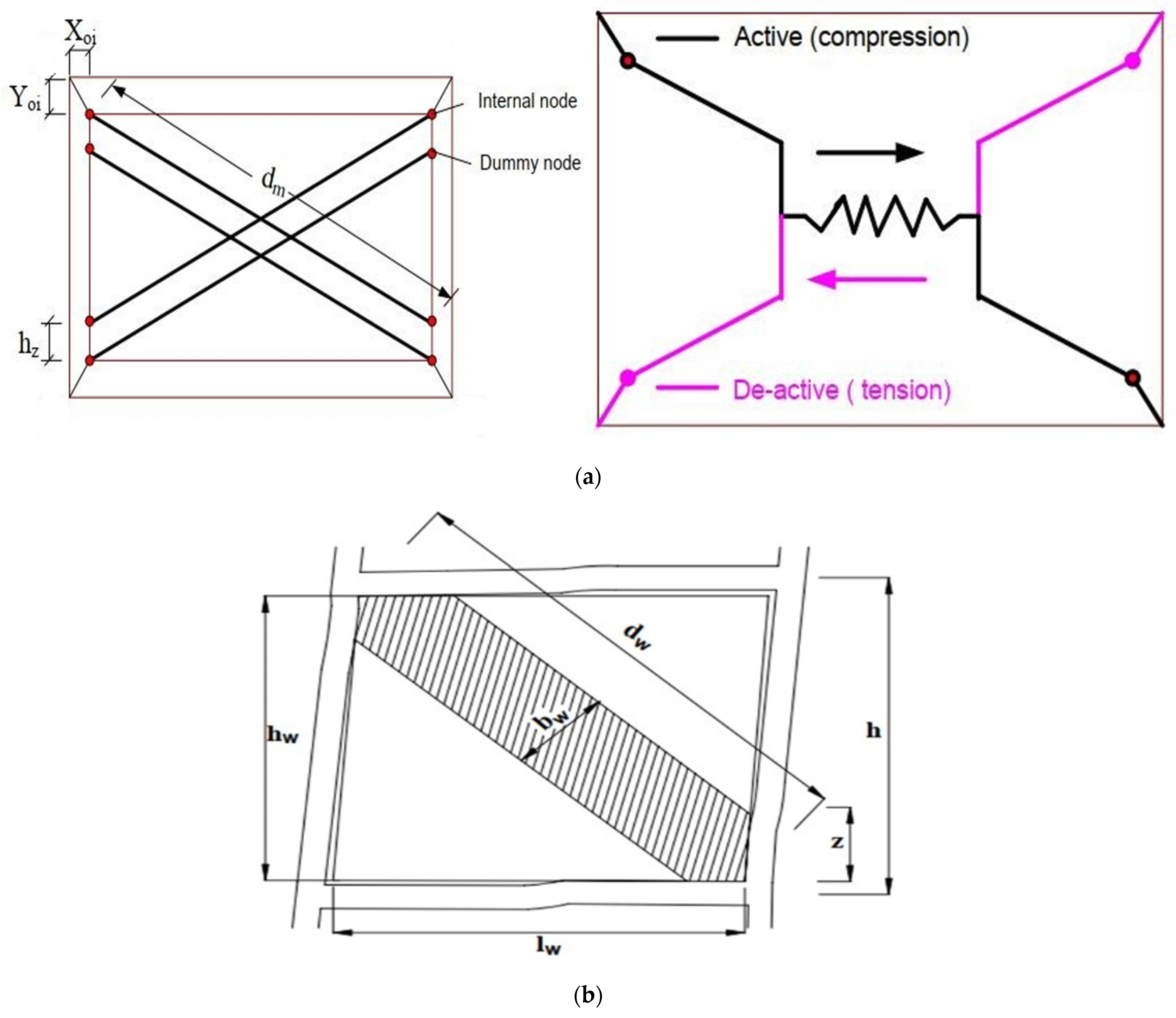
2.3.2. Gravity Loads
2.3.3. Seismic Loads

2.4. Development of Seismic Fragility Curves
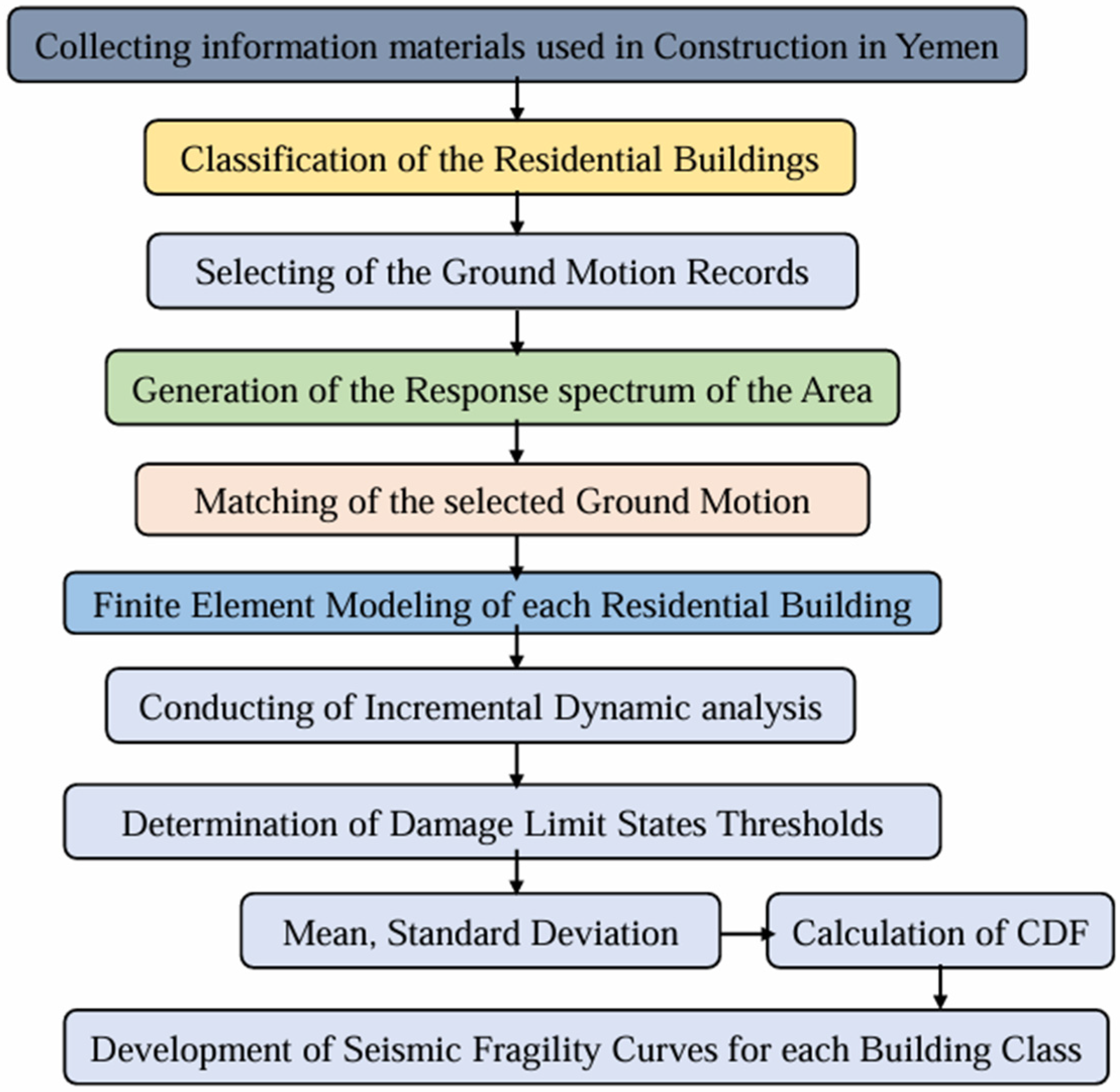
2.5. Definition of Damage Limit States
2.5.1. Immediate Occupancy (IO)
2.5.2. Life Safety (LS)
2.5.3. Collapse Prevention (CP)
3. Results and Discussion
3.1. Nonlinear Response over the Height of the Structures
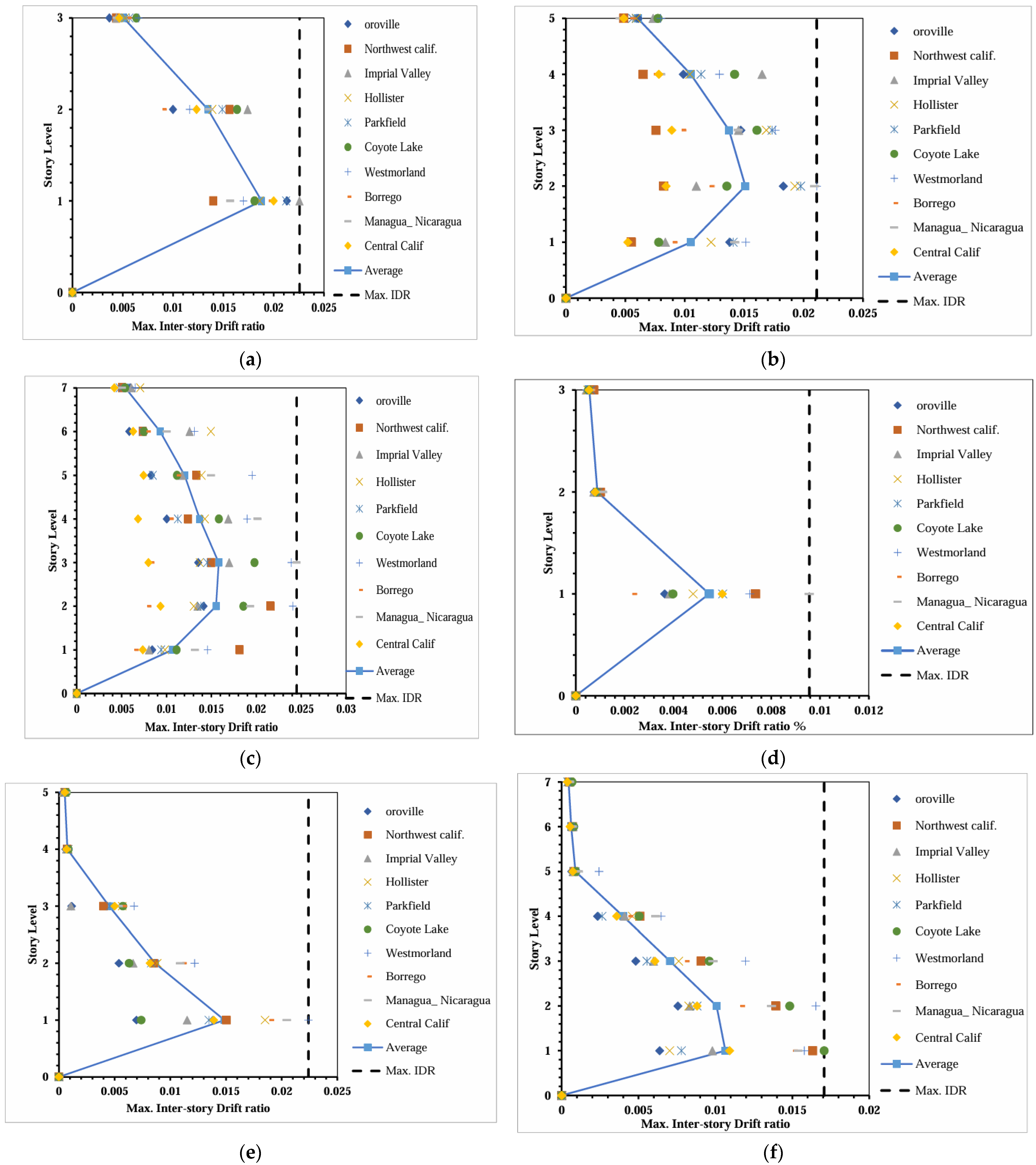
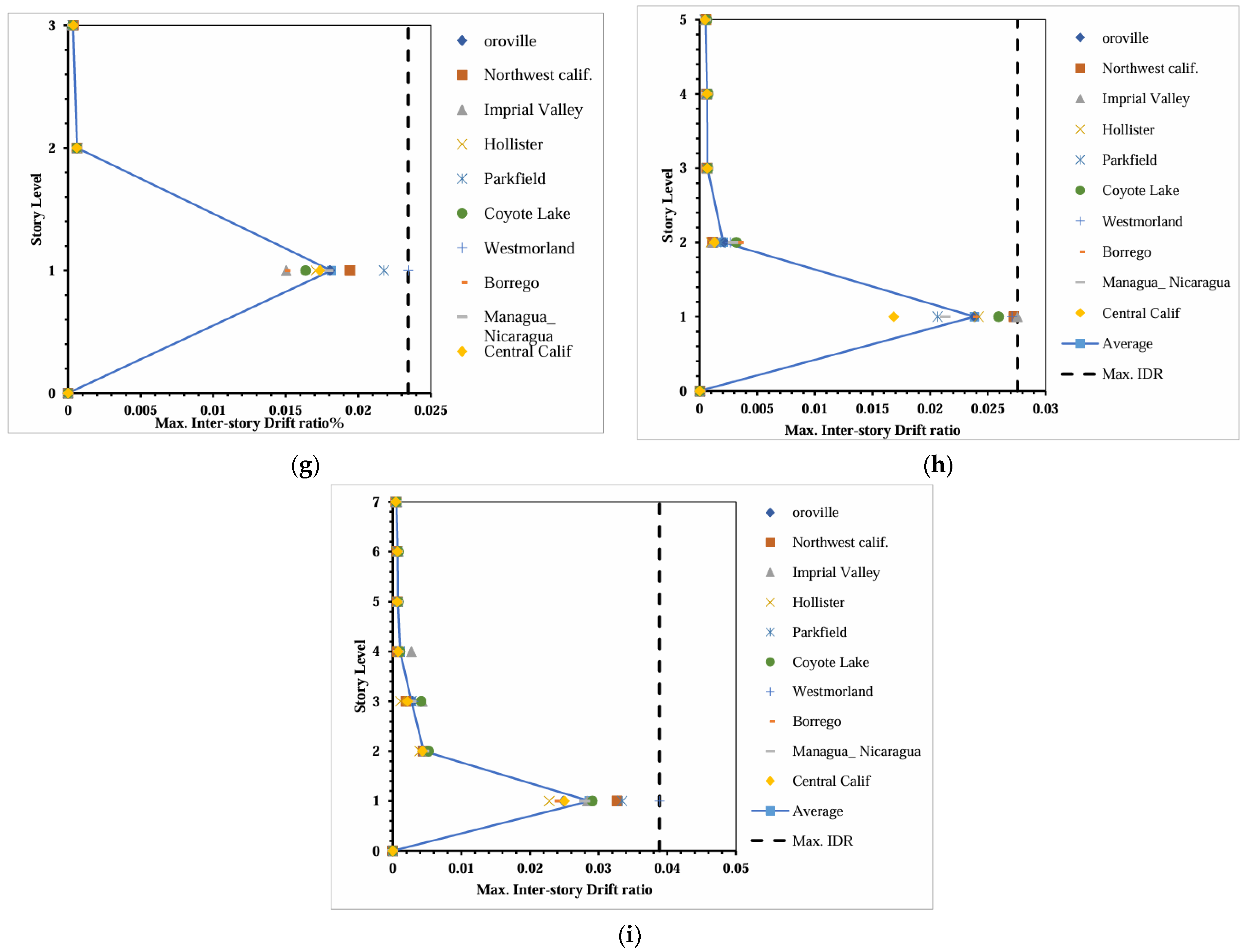
3.2. Incremental Dynamic Analysis Curves

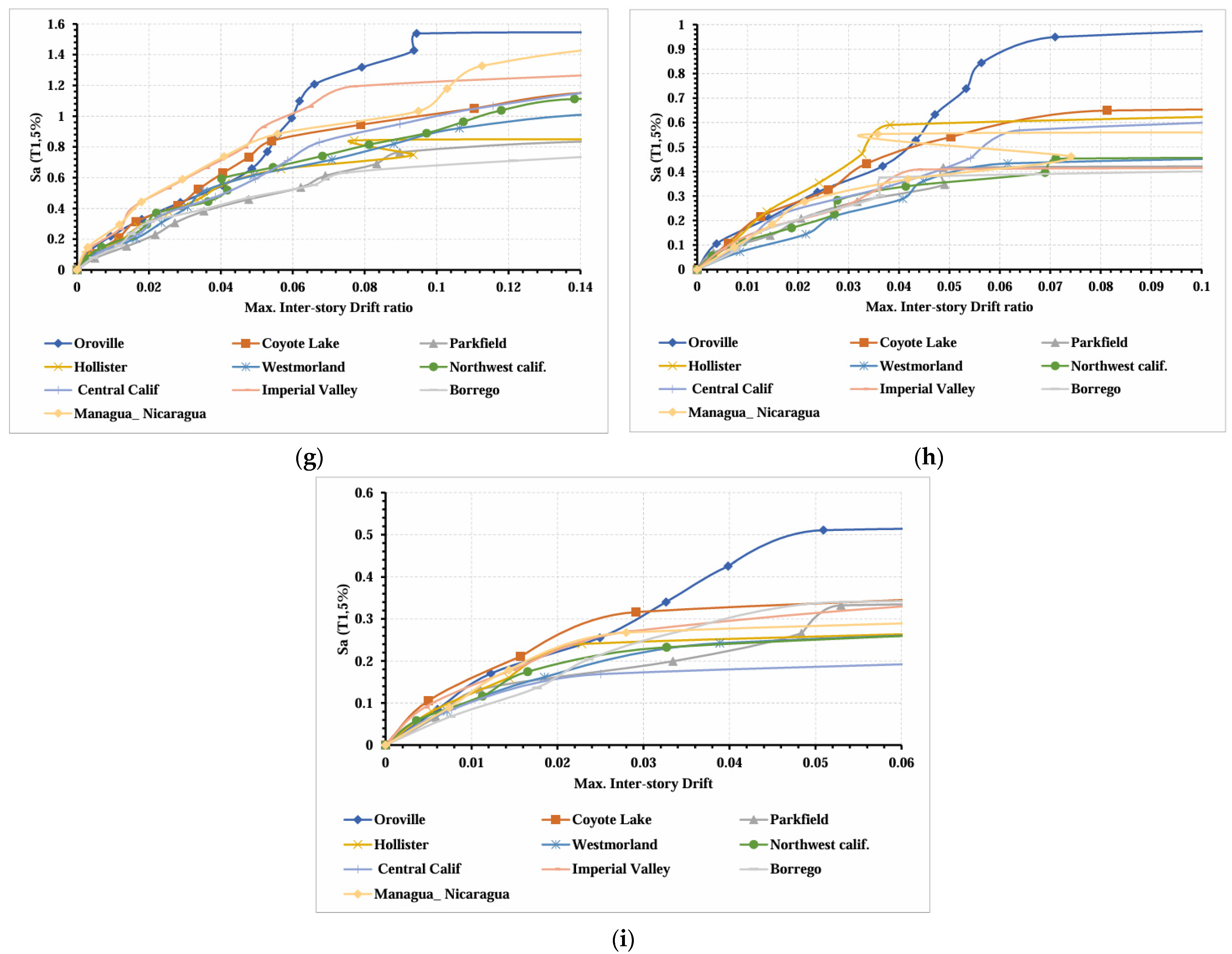
3.3. Damage Limit States


3.4. Fragility Curves
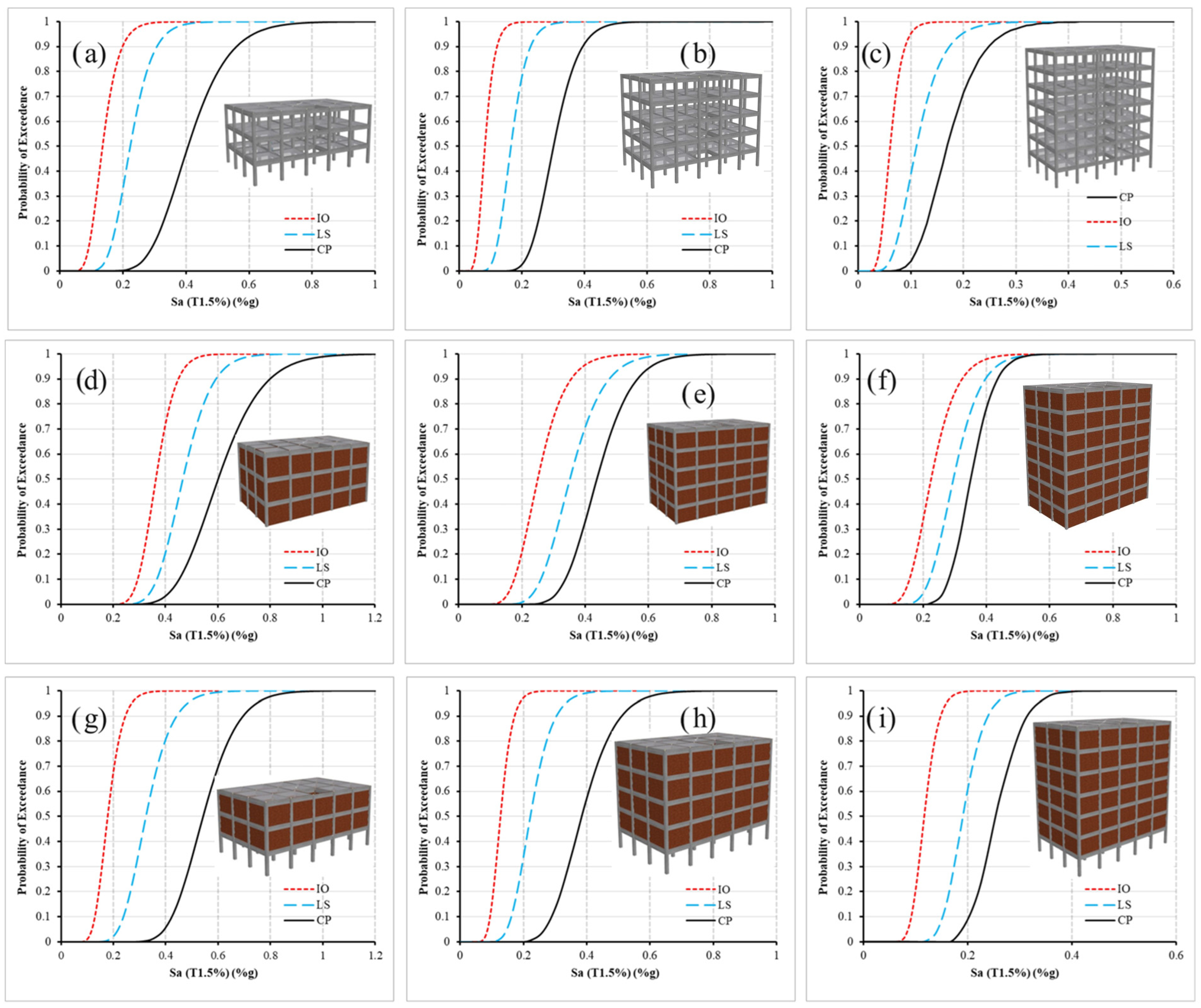
3.5. The Effect of Different Parameters According to Fragility Curves
3.5.1. The Effect of the Height on the Performance

| Sa (%g) | IO | LS | CP | ||||||
|---|---|---|---|---|---|---|---|---|---|
| BF3 | BF5 | BF7 | BF3 | BF5 | BF7 | BF3 | BF5 | BF7 | |
| 0 | 0 | 0 | 0 | 0 | 0 | 0 | 0 | 0 | 0 |
| 0.1 | 0.16 | 0.74 | 0.95 | 0 | 0.02 | 0.38 | 0 | 0 | 0.04 |
| 0.2 | 0.9 | 1 | 1 | 0.33 | 0.78 | 0.95 | 0 | 0.03 | 0.71 |
| 0.3 | 1 | 1 | 1 | 0.88 | 0.99 | 1 | 0.11 | 0.49 | 0.97 |
| 0.4 | 1 | 1 | 1 | 0.99 | 1 | 1 | 0.47 | 0.91 | 1 |
| 0.5 | 1 | 1 | 1 | 1 | 1 | 1 | 0.8 | 0.99 | 1 |
| 0.6 | 1 | 1 | 1 | 1 | 1 | 1 | 0.94 | 1 | 1 |
| 0.7 | 1 | 1 | 1 | 1 | 1 | 1 | 0.99 | 1 | 1 |
| 0.8 | 1 | 1 | 1 | 1 | 1 | 1 | 1 | 1 | 1 |
| 0.9 | 1 | 1 | 1 | 1 | 1 | 1 | 1 | 1 | 1 |
| 1 | 1 | 1 | 1 | 1 | 1 | 1 | 1 | 1 | 1 |

| Sa (%g) | IO | LS | CP | ||||||
|---|---|---|---|---|---|---|---|---|---|
| IF3 | IF5 | IF7 | IF3 | IF5 | IF7 | IF3 | IF5 | IF7 | |
| 0 | 0 | 0 | 0 | 0 | 0 | 0 | 0 | 0 | 0 |
| 0.1 | 0 | 0 | 0 | 0 | 0 | 0 | 0 | 0 | 0 |
| 0.2 | 0 | 0.21 | 0.33 | 0 | 0.01 | 0.04 | 0 | 0 | 0 |
| 0.3 | 0.13 | 0.74 | 0.84 | 0.01 | 0.25 | 0.52 | 0 | 0.03 | 0.18 |
| 0.4 | 0.72 | 0.96 | 0.98 | 0.21 | 0.71 | 0.91 | 0.03 | 0.33 | 0.78 |
| 0.5 | 0.97 | 0.99 | 1 | 0.65 | 0.93 | 0.99 | 0.2 | 0.75 | 0.98 |
| 0.6 | 1 | 1 | 1 | 0.91 | 0.99 | 1 | 0.5 | 0.94 | 1 |
| 0.7 | 1 | 1 | 1 | 0.99 | 1 | 1 | 0.75 | 0.99 | 1 |
| 0.8 | 1 | 1 | 1 | 1 | 1 | 1 | 0.9 | 1 | 1 |
| 0.9 | 1 | 1 | 1 | 1 | 1 | 1 | 0.97 | 1 | 1 |
| 1 | 1 | 1 | 1 | 1 | 1 | 1 | 0.99 | 1 | 1 |

| Sa (%g) | IO | LS | CP | ||||||
|---|---|---|---|---|---|---|---|---|---|
| SSF3 | SSF5 | SSF7 | SSF3 | SSF5 | SSF7 | SSF3 | SSF5 | SSF7 | |
| 0 | 0 | 0 | 0 | 0 | 0 | 0 | 0 | 0 | 0 |
| 0.1 | 0.01 | 0.15 | 0.21 | 0 | 0 | 0 | 0 | 0 | 0 |
| 0.2 | 0.68 | 0.97 | 1 | 0.02 | 0.34 | 0.61 | 0 | 0 | 0.08 |
| 0.3 | 0.98 | 1 | 1 | 0.38 | 0.89 | 1 | 0 | 0.13 | 0.84 |
| 0.4 | 1 | 1 | 1 | 0.81 | 0.99 | 1 | 0.06 | 0.57 | 1 |
| 0.5 | 1 | 1 | 1 | 0.96 | 1 | 1 | 0.34 | 0.88 | 1 |
| 0.6 | 1 | 1 | 1 | 0.99 | 1 | 1 | 0.7 | 0.98 | 1 |
| 0.7 | 1 | 1 | 1 | 1 | 1 | 1 | 0.91 | 1 | 1 |
| 0.8 | 1 | 1 | 1 | 1 | 1 | 1 | 0.98 | 1 | 1 |
| 0.9 | 1 | 1 | 1 | 1 | 1 | 1 | 1 | 1 | 1 |
| 1 | 1 | 1 | 1 | 1 | 1 | 1 | 1 | 1 | 1 |
3.5.2. The Effect of the Infill Wall on the Performance

| Sa (%g) | IO | LS | CP | |||
|---|---|---|---|---|---|---|
| BF3 | IF3 | BF3 | IF3 | BF3 | IF3 | |
| 0 | 0 | 0 | 0 | 0 | 0 | 0 |
| 0.1 | 0.16 | 0 | 0 | 0 | 0 | 0 |
| 0.2 | 0.9 | 0 | 0.33 | 0 | 0 | 0 |
| 0.3 | 1 | 0.13 | 0.88 | 0.01 | 0.11 | 0 |
| 0.4 | 1 | 0.72 | 0.99 | 0.21 | 0.47 | 0.03 |
| 0.5 | 1 | 0.97 | 1 | 0.65 | 0.8 | 0.2 |
| 0.6 | 1 | 1 | 1 | 0.91 | 0.94 | 0.5 |
| 0.7 | 1 | 1 | 1 | 0.99 | 0.99 | 0.75 |
| 0.8 | 1 | 1 | 1 | 1 | 1 | 0.9 |
| 0.9 | 1 | 1 | 1 | 1 | 1 | 0.97 |
| 1 | 1 | 1 | 1 | 1 | 1 | 0.99 |

| Sa (%g) | IO | LS | CP | |||
|---|---|---|---|---|---|---|
| BF5 | IF5 | BF5 | IF5 | BF5 | IF5 | |
| 0 | 0 | 0 | 0 | 0 | 0 | 0 |
| 0.1 | 0.74 | 0 | 0.02 | 0 | 0 | 0 |
| 0.2 | 1 | 0.21 | 0.78 | 0.01 | 0.03 | 0 |
| 0.3 | 1 | 0.74 | 0.99 | 0.25 | 0.49 | 0.03 |
| 0.4 | 1 | 0.96 | 1 | 0.71 | 0.91 | 0.33 |
| 0.5 | 1 | 0.99 | 1 | 0.93 | 0.99 | 0.75 |
| 0.6 | 1 | 1 | 1 | 0.99 | 1 | 0.94 |
| 0.7 | 1 | 1 | 1 | 1 | 1 | 0.99 |
| 0.8 | 1 | 1 | 1 | 1 | 1 | 1 |
| 0.9 | 1 | 1 | 1 | 1 | 1 | 1 |

| Sa (%g) | IO | LS | CP | |||
|---|---|---|---|---|---|---|
| BF7 | IF7 | BF7 | IF7 | BF7 | IF7 | |
| 0 | 0 | 0 | 0 | 0 | 0 | 0 |
| 0.1 | 0.95 | 0 | 0.38 | 0 | 0.04 | 0 |
| 0.2 | 1 | 0.33 | 0.95 | 0.04 | 0.71 | 0 |
| 0.3 | 1 | 0.84 | 1 | 0.52 | 0.97 | 0.18 |
| 0.4 | 1 | 0.98 | 1 | 0.91 | 1 | 0.78 |
| 0.5 | 1 | 1 | 1 | 0.99 | 1 | 0.98 |
| 0.6 | 1 | 1 | 1 | 1 | 1 | 1 |
| 0.7 | 1 | 1 | 1 | 1 | 1 | 1 |
| 0.8 | 1 | 1 | 1 | 1 | 1 | 1 |
| 0.9 | 1 | 1 | 1 | 1 | 1 | 1 |
| 1 | 1 | 1 | 1 | 1 | 1 | 1 |
3.5.3. The Effect of the Soft-Story on the Performance

| Sa (%g) | IO | LS | CP | |||
|---|---|---|---|---|---|---|
| SSF3 | IF3 | SSF3 | IF3 | SSF3 | IF3 | |
| 0 | 0 | 0 | 0 | 0 | 0 | 0 |
| 0.1 | 0.01 | 0 | 0 | 0 | 0 | 0 |
| 0.2 | 0.68 | 0 | 0.02 | 0 | 0 | 0 |
| 0.3 | 0.98 | 0.13 | 0.38 | 0.01 | 0 | 0 |
| 0.4 | 1 | 0.72 | 0.81 | 0.21 | 0.06 | 0.03 |
| 0.5 | 1 | 0.97 | 0.96 | 0.65 | 0.34 | 0.2 |
| 0.6 | 1 | 1 | 0.99 | 0.91 | 0.7 | 0.5 |
| 0.7 | 1 | 1 | 1 | 0.99 | 0.91 | 0.75 |
| 0.8 | 1 | 1 | 1 | 1 | 0.98 | 0.9 |
| 0.9 | 1 | 1 | 1 | 1 | 1 | 0.97 |
| 1 | 1 | 1 | 1 | 1 | 1 | 0.99 |
| Sa (%g) | IO | LS | CP | |||
|---|---|---|---|---|---|---|
| SSF5 | IF5 | SSF5 | IF5 | SSF5 | IF5 | |
| 0 | 0 | 0 | 0 | 0 | 0 | 0 |
| 0.1 | 0.15 | 0 | 0 | 0 | 0 | 0 |
| 0.2 | 0.97 | 0.21 | 0.34 | 0.01 | 0 | 0 |
| 0.3 | 1 | 0.74 | 0.89 | 0.25 | 0.13 | 0.03 |
| 0.4 | 1 | 0.96 | 0.99 | 0.71 | 0.57 | 0.33 |
| 0.5 | 1 | 0.99 | 1 | 0.93 | 0.88 | 0.75 |
| 0.6 | 1 | 1 | 1 | 0.99 | 0.98 | 0.94 |
| 0.7 | 1 | 1 | 1 | 1 | 1 | 0.99 |
| 0.8 | 1 | 1 | 1 | 1 | 1 | 1 |
| 0.9 | 1 | 1 | 1 | 1 | 1 | 1 |
| 1 | 1 | 1 | 1 | 1 | 1 | 1 |

| Sa (%g) | IO | LS | CP | |||
|---|---|---|---|---|---|---|
| SSF7 | IF7 | SSF7 | IF7 | SSF7 | IF7 | |
| 0 | 0 | 0 | 0 | 0 | 0 | 0 |
| 0.1 | 0.21 | 0 | 0 | 0 | 0 | 0 |
| 0.2 | 1 | 0.33 | 0.61 | 0.04 | 0.08 | 0 |
| 0.3 | 1 | 0.84 | 1 | 0.52 | 0.84 | 0.18 |
| 0.4 | 1 | 0.98 | 1 | 0.91 | 1 | 0.78 |
| 0.5 | 1 | 1 | 1 | 0.99 | 1 | 0.98 |
| 0.6 | 1 | 1 | 1 | 1 | 1 | 1 |
| 0.7 | 1 | 1 | 1 | 1 | 1 | 1 |
| 0.8 | 1 | 1 | 1 | 1 | 1 | 1 |
| 0.9 | 1 | 1 | 1 | 1 | 1 | 1 |
| 1 | 1 | 1 | 1 | 1 | 1 | 1 |

4. Conclusions
- As building height increases, structures become more susceptible to damage under lower spectral acceleration (Sa) values. For instance, in bare-frame buildings (BF), the probability of exceeding the Collapse Prevention (CP) limit at Sa = 0.3 g rises from 11% in BF3 to 97% in BF7. Similar trends are observed for fully infilled frames (IF) and soft-story frames (SSF), indicating that taller buildings exhibit lower damage thresholds and higher fragility.
- Infill walls significantly improve seismic performance by increasing lateral stiffness and reducing inter-story drifts. For example, at Sa = 0.4 g, the probability of exceeding CP in BF3 is 47%, while it drops to only 3% in IF3. Similarly, BF5 and IF5 show CP exceedance probabilities of 73% and 33%, respectively. This demonstrates that infill walls can delay structural damage and collapse under seismic loading.
- The soft story notably weakens seismic resilience, concentrating damage in the first story. In SSF7, the probability of exceeding CP at Sa = 0.4 g reaches 100%, in contrast to 78% in IF7 and 97% in BF7. The soft-story effect also leads to higher inter-story drift ratios at the lower levels, posing a critical failure risk.
- IDA curves show structures enter nonlinear behavior at moderate Sa levels and may exhibit hardening or softening responses. Buildings subjected to the Oroville earthquake exhibit higher IM values before the collapse, while Parkfield results in earlier failure. The IF3 building showed the most robust seismic response among all typologies.
- Across all configurations, the immediate occupancy (IO), life safety (LS), and collapse prevention (CP) states were reached at progressively lower Sa values with increasing building height and the presence of soft stories. For example, BF7 reached CP at Sa ≈ 0.28 g, IF7 at 0.45 g, and SSF7 at just 0.32 g.
Author Contributions
Funding
Data Availability Statement
Conflicts of Interest
References
- Lemenkova, P. Seismicity in Yemen and the Gulf of Aden in a Geological Context. Rev. RISCURI SI Catastr. 2021, 28, 43–57. [Google Scholar] [CrossRef] [PubMed]
- Sultan, B. Modern/Traditional Buildings in Yemen and Sustainability. In Proceedings of the First Engineering Conference of Yemeni Architecture and the Challenges of the Age—Aden University, Aden, Yemen, 28–30 January 2008; pp. 1–10. [Google Scholar]
- Alwathaf, A.H. Structural Condition Assessment and Retrofit of Reinforced Concrete Columns. Acad. J. Sci. CD-ROM 2014, 3, 85–97. [Google Scholar]
- Pavel, F. Collapse assessment for code-conforming reinforced concrete frame structures in Romania. Front. Built Environ. 2018, 4, 50. [Google Scholar] [CrossRef]
- De Risi, M.T.; Di Domenico, M.; Manfredi, V.; Terrenzi, M.; Camata, G.; Mollaioli, F.; Noto, F.; Ricci, P.; Franchin, P.; Masi, A.; et al. Modelling and seismic response analysis of Italian pre-code and low-code reinforced concrete buildings. Part I: Bare frames. J. Earthq. Eng. 2023, 27, 1482–1513. [Google Scholar] [CrossRef]
- De Risi, M.T.; Di Domenico, M.; Manfredi, V.; Terrenzi, M.; Camata, G.; Mollaioli, F.; Noto, F.; Ricci, P.; Franchin, P.; Masi, A.; et al. Modelling and seismic response analysis of Italian pre-code and low-code reinforced concrete buildings. Part II: Infilled frames. J. Earthq. Eng. 2023, 27, 1534–1564. [Google Scholar]
- Liel, A.B.; Haselton, C.B.; Deierlein, G.G. Seismic collapse safety of reinforced concrete buildings. II: Comparative assessment of nonductile and ductile moment frames. J. Struct. Eng. 2011, 137, 492–502. [Google Scholar] [CrossRef]
- Haselton, C.B.; Liel, A.B.; Deierlein, G.G.; Dean, B.S.; Chou, J.H. Seismic collapse safety of reinforced concrete buildings. I: Assessment of ductile moment frames. J. Struct. Eng. 2011, 137, 481–491. [Google Scholar] [CrossRef]
- Noh, N.M.; Tesfamariam, S. Seismic collapse risk assessment of code-conforming RC moment resisting frame buildings designed with 2014 Canadian Standard Association Standard A23.3. Front. Built Environ. 2018, 4, 53. [Google Scholar] [CrossRef]
- Arya, A.S.; Srivastava, L.S.; Gupta, S.P. Survey of Damages during the Dhamar Earthquake of 13 December 1982 in the Yemen Arab Republic. Bull. Seism. Soc. Am. 1985, 75, 597–610. [Google Scholar] [CrossRef]
- Hughes, R.; Collings, A. Seismic and Volcanic Hazards Affecting the Vulnerability of the Sana’a Area of Yemen. In The Archaeology of Geological Catastrophes; Geological Society of London: London, UK, 2000; Volume 171, pp. 355–372. [Google Scholar] [CrossRef]
- Zaid, H.A.H.; Jamaluddin, T.A.; Arifin, M.H. Overview of Slope Stability, Earthquakes, Flash Floods and Expansive Soil Hazards in the Republic of Yemen. Bull. Geol. Soc. Malays. 2021, 71, 71–78. [Google Scholar] [CrossRef]
- Al-masni, M.A. Earthquake Building Risk Assessment in Sana’a City, Yemen; Asian Disaster Reduction Center: Kobe, Japan, 2012; Volume 2012. [Google Scholar]
- Hueste, M.B.D.; Bai, J.W. Seismic Retrofit of a Reinforced Concrete Flat-Slab Structure: Part II—Seismic Fragility Analysis. Eng. Struct. 2007, 29, 1178–1188. [Google Scholar] [CrossRef]
- Agency, F.E.M.; Washington, D. Commentary for the Seismic Rehabilitation of Buildings (FEMA356); Federal Emergency Management Agency: Washington, CA, USA, 2000. [Google Scholar]
- Kappos, A.J.; Panagopoulos, G. Fragility Curves for Reinforced Concrete Buildings in Greece. Struct. Infrastruct. Eng. 2010, 6, 39–53. [Google Scholar] [CrossRef]
- Su, R.K.L.; Lee, C.L. Development of Seismic Fragility Curves for Low-Rise Masonry Infilled Reinforced Concrete Buildings by a Coefficient-Based Method. Earthq. Eng. Eng. Vib. 2013, 12, 319–332. [Google Scholar] [CrossRef]
- Ulrich, T.; Negulescu, C.; Douglas, J. Fragility Curves for Risk-Targeted Seismic Design Maps. Bull. Earthq. Eng. 2014, 12, 1479–1491. [Google Scholar] [CrossRef]
- EC2; Eurocode 2: Design of Concrete Structures. European Commitee for Standardization: Brussels, Belgium, 1992.
- EC8; Standardization for Eurocode 8: Design of Structures for Earthquake Resistance. European Committee for Standardization: Brussels, Belgium, 1998; Volume 3.
- Vamvatsikos, D.; Allin Cornell, C. Incremental Dynamic Analysis. Earthq. Eng. Struct. Dyn. 2002, 31, 491–514. [Google Scholar] [CrossRef]
- Chowdhury, S.; Banerjee, A.; Adhikari, S. Optimal Design of Inertial Amplifier Base Isolators for Dynamic Response Control of Multi-Storey Buildings. Int. J. Struct. Stab. Dyn. 2023, 23, 2350047. [Google Scholar] [CrossRef]
- Huang, Z.K.; Pitilakis, K.; Argyroudis, S.; Tsinidis, G.; Zhang, D.M. Selection of Optimal Intensity Measures for Fragility Assessment of Circular Tunnels in Soft Soil Deposits. Soil Dyn. Earthq. Eng. 2021, 145, 106724. [Google Scholar] [CrossRef]
- Kassem, M.M.; Nazri, F.M.; El-Maissi, A.M. The Influence of Slope Angle Variation on Structures Resting on Hilly Region Considering Soil–Structure Interaction Under Earthquake Loadings Using Capacity Curves and Probabilistic Approach. J. Earthq. Eng. 2024, 28, 1818–1836. [Google Scholar] [CrossRef]
- Raj, D.; Singh, Y.; Kaynia, A.M. Seismic Fragility Analysis of Coupled Building-Slope Systems. Earthq. Eng. Struct. Dyn. 2024, 53, 116–137. [Google Scholar] [CrossRef]
- Zhong, Z.; Shen, Y.; Zhao, M.; Li, L.; Du, X.; Hao, H. Seismic Fragility Assessment of the Daikai Subway Station in Layered Soil. Soil Dyn. Earthq. Eng. 2020, 132, 106044. [Google Scholar] [CrossRef]
- Jiang, J.; El Naggar, M.H.; Huang, W.; Xu, C.; Zhao, K.; Du, X. Seismic Vulnerability Analysis for Shallow-Buried Underground Frame Structure Considering 18 Existing Subway Stations. Soil Dyn. Earthq. Eng. 2022, 162, 107479. [Google Scholar] [CrossRef]
- Huang, Z.; Cheng, Y.; Zhang, D.; Yan, D.; Shen, Y. Seismic Fragility and Resilience Assessment of Shallowly Buried Large-Section Underground Civil Defense Structure in Soft Soils: Framework and Application. Tunn. Undergr. Space Technol. 2024, 146, 105640. [Google Scholar] [CrossRef]
- Valente, M. Seismic upgrading strategies for non-ductile plan-wise irregular R/C structures. Procedia Eng. 2013, 54, 539–553. [Google Scholar] [CrossRef]
- Valente, M.; Gabriele, M. Alternative retrofitting strategies to prevent the failure of an under-designed reinforced concrete frame. Eng. Fail. Anal. 2018, 89, 271–285. [Google Scholar] [CrossRef]
- ACI 318-02; Building Code Requirements for Structural Concrete and Commentary. American Concrete Institute: Farmington Hills, MI, USA, 2002.
- Seismosoft. SeismoStruct—A Computer Program for Static and Dynamic Nonlinear Analysis of Framed Structures; SeismoSoft: Pavia, Italy, 2020; Available online: http://www.seismosoft.com (accessed on 13 January 2025).
- SeismoSignal—A Computer Program for Signal Processing of Strong-Motion Data; ver.3.1.0; SeismoSoft: Pavia, Italy, 2004; Available online: http://www.seismosoft.com (accessed on 13 January 2025).
- Seismosoft. SeismoMatch, version 2.0.0; SeismoSoft: Pavia, Italy, 2012. Available online: http://www.seismosoft.com (accessed on 13 January 2025).
- Eniyew, T.; Asmare, A.; Dewulf, W. Yield strength and ductility analysis on steel reinforcing bars used in Ethiopian construction industry. In Advances of Science and Technology, Proceedings of the 8th EAI International Conference, ICAST 2020, Bahir Dar, Ethiopia, 2–4 October 2020; Proceedings, Part II 8; Springer International Publishing: Cham, Switzerland, 2021; pp. 302–314. [Google Scholar]
- Khan, N.M. Evaluation of Seismic Performance of RC Frame Structures by Pushover and Time History Analyses. Bachelor’s Thesis, Bangladesh University of Engineering and Technology, Dhaka, Bangladesh, 2013. [Google Scholar]
- Koupaei, A.E.; Saffari, H.; Ardakani, R.R. Investigating the Effect of Earthquake Duration on Concrete Structures by Analyzing the Frequency Content of Acceleration Time History. J. Rehabil. Civ. Eng. 2021, 9, 21–40. [Google Scholar] [CrossRef]
- Bhavnani, M.S.; Sheth, R.K. A Comparative Study of Seismic Performance of RC Frame-Wall Structures Designed as Per Various International Codes. In Symposium in Earthquake Engineering; Springer Nature: Singapore, 2023; Volume 329, pp. 195–217. [Google Scholar] [CrossRef]
- Loads, M.D. Minimum Design Loads and Associated Criteria for Buildings and Other Structures; American Society of Civil Engineers: Reston, VA, USA, 2017. [Google Scholar]
- Bariker, P.; Kolathayar, S. Dynamic Soil Structure Interaction of a High-Rise Building Resting over a Finned Pile Mat. Infrastructures 2022, 7, 142. [Google Scholar] [CrossRef]
- Ciaponi, C. Design Verification of a Displacement-Based Designed Three Dimensional Wall-Steel Frame Building. Master’s Thesis, European School for Advanced Studies in Reduction of Seismic Risk, Rose School, Pavia, Italy, 2008. [Google Scholar]
- Crisafulli, F.J. Seismic Behaviour of Reinforced Concrete Structures with Masonry Infills. Ph.D. Thesis, University of Canterbury, Christchurch, New Zealand, 1997. [Google Scholar]
- PEER Technical Report for the Ground Motion Database Web. Available online: http://peer.berkeley.edu/peer_ground_motion_database (accessed on 13 January 2025).
- Mohindra, R.; Nair, A.K.S.; Gupta, S.; Sur, U.; Sokolov, V. Probabilistic seismic hazard analysis for Yemen. Int. J. Geophys. 2012, 2012, 304235. [Google Scholar] [CrossRef]
- UBC97, Uniform Building Code; Council Code International: Washington, DC, USA, 1997.
- Du, X.; Jiang, J.; El Naggar, M.H.; Xu, C.; Xu, Z. Interstory Drift Ratio Associated with Performance Objectives for Shallow-Buried Multistory and Span Subway Stations in Inhomogeneous Soil Profiles. Earthq. Eng. Struct. Dyn. 2021, 50, 655–672. [Google Scholar] [CrossRef]
- Asgarkhani, N.; Kazemi, F.; Jankowski, R. Machine Learning-Based Prediction of Residual Drift and Seismic Risk Assessment of Steel Moment-Resisting Frames Considering Soil-Structure Interaction. Comput. Struct. 2023, 289, 107181. [Google Scholar] [CrossRef]
- Manos, G.C.; Katakalos, K.; Soulis, V.; Melidis, L. Earthquake Retrofitting of Soft-Story RC Frame Structures with RC Infills. Appl. Sci. 2022, 12, 11597. [Google Scholar] [CrossRef]
- Wang, F.; Zhao, K.; Zhang, J.; Yan, K. Influence of Different Types of Infill Walls on the Hysteretic Performance of Reinforced Concrete Frames. Buildings 2021, 11, 301. [Google Scholar] [CrossRef]
- Kazemi, F.; Mohebi, B.; Jankowski, R. Predicting the Seismic Collapse Capacity of Adjacent SMRFs Retrofitted with Fluid Viscous Dampers in Pounding Condition. Mech. Syst. Signal Process. 2021, 161, 107939. [Google Scholar] [CrossRef]
- Ruggieri, S.; Porco, F.; Uva, G.; Vamvatsikos, D. Two Frugal Options to Assess Class Fragility and Seismic Safety for Low-Rise Reinforced Concrete School Buildings in Southern Italy. Bull. Earthq. Eng. 2021, 19, 1415–1439. [Google Scholar] [CrossRef]
- Andreotti, G.; Lai, C.G. Use of Fragility Curves to Assess the Seismic Vulnerability in the Risk Analysis of Mountain Tunnels. Tunn. Undergr. Space Technol. 2019, 91, 103008. [Google Scholar] [CrossRef]
- FEMA356; Prestandard and Commentary for the Rehabilitation of Buildings. Fedral Emergency Management Agency: Washington, DC, USA, 2000.
Disclaimer/Publisher’s Note: The statements, opinions and data contained in all publications are solely those of the individual author(s) and contributor(s) and not of MDPI and/or the editor(s). MDPI and/or the editor(s) disclaim responsibility for any injury to people or property resulting from any ideas, methods, instructions or products referred to in the content. |
© 2025 by the authors. Licensee MDPI, Basel, Switzerland. This article is an open access article distributed under the terms and conditions of the Creative Commons Attribution (CC BY) license (https://creativecommons.org/licenses/by/4.0/).
Share and Cite
Radman Ahmed, A.A.; Lu, L.; Li, B.; Bi, W.; Al-Dhubai, F.M.A. Seismic Vulnerability Assessment of Residential RC Buildings in Yemen Using Incremental Dynamic Analysis (IDA). Buildings 2025, 15, 1336. https://doi.org/10.3390/buildings15081336
Radman Ahmed AA, Lu L, Li B, Bi W, Al-Dhubai FMA. Seismic Vulnerability Assessment of Residential RC Buildings in Yemen Using Incremental Dynamic Analysis (IDA). Buildings. 2025; 15(8):1336. https://doi.org/10.3390/buildings15081336
Chicago/Turabian StyleRadman Ahmed, Amr Ahmed, Linfeng Lu, Bo Li, Wei Bi, and Fawziah Mohammed Abdullah Al-Dhubai. 2025. "Seismic Vulnerability Assessment of Residential RC Buildings in Yemen Using Incremental Dynamic Analysis (IDA)" Buildings 15, no. 8: 1336. https://doi.org/10.3390/buildings15081336
APA StyleRadman Ahmed, A. A., Lu, L., Li, B., Bi, W., & Al-Dhubai, F. M. A. (2025). Seismic Vulnerability Assessment of Residential RC Buildings in Yemen Using Incremental Dynamic Analysis (IDA). Buildings, 15(8), 1336. https://doi.org/10.3390/buildings15081336







